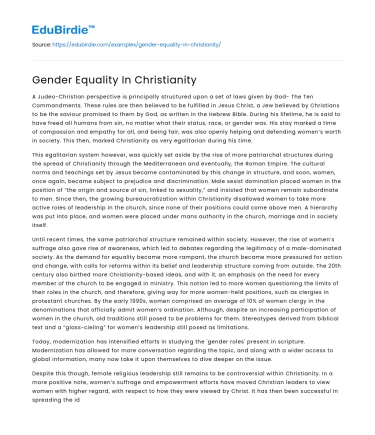A Judeo-Christian perspective is principally structured upon a set of laws given by God- The Ten Commandments. These rules are then believed to be fulfilled in Jesus Christ, a Jew believed by Christians to be the saviour promised to them by God, as written in the Hebrew Bible. During his lifetime, he is said to have freed all humans from sin, no matter what their status, race, or gender was. His stay marked a time of compassion and empathy for all, and being fair, was also openly helping and defending women’s worth in society. This then, marked Christianity as very egalitarian during his time.
This egalitarian system however, was quickly set aside by the rise of more patriarchal structures during the spread of Christianity through the Mediterranean and eventually, the Roman Empire. The cultural norms and teachings set by Jesus became contaminated by this change in structure, and soon, women, once again, became subject to prejudice and discrimination. Male sexist domination placed women in the position of “the origin and source of sin, linked to sexuality,” and insisted that women remain subordinate to men. Since then, the growing bureaucratization within Christianity disallowed women to take more active roles of leadership in the church, since none of their positions could come above men. A hierarchy was put into place, and women were placed under mans authority in the church, marriage and in society itself.
Save your time!
We can take care of your essay
- Proper editing and formatting
- Free revision, title page, and bibliography
- Flexible prices and money-back guarantee
Until recent times, the same patriarchal structure remained within society. However, the rise of women’s suffrage also gave rise of awareness, which led to debates regarding the legitimacy of a male-dominated society. As the demand for equality became more rampant, the church became more pressured for action and change, with calls for reforms within its belief and leadership structure coming from outside. The 20th century also birthed more Christianity-based ideas, and with it, an emphasis on the need for every member of the church to be engaged in ministry. This notion led to more women questioning the limits of their roles in the church, and therefore, giving way for more women-held positions, such as clergies in protestant churches. By the early 1990s, women comprised an average of 10% of women clergy in the denominations that officially admit women’s ordination. Although, despite an increasing participation of women in the church, old traditions still posed to be problems for them. Stereotypes derived from biblical text and a “glass-cieling” for women’s leadership still posed as limitations.
Today, modernization has intensified efforts in studying the 'gender roles' present in scripture. Modernization has allowed for more conversation regarding the topic, and along with a wider access to global information, many now take it upon themselves to dive deeper on the issue.
Despite this though, female religious leadership still remains to be controversial within Christianity. In a more positive note, women’s suffrage and empowerment efforts have moved Christian leaders to view women with higher regard, with respect to how they were viewed by Christ. It has then been successful in spreading the idea that men and women are fundamentally equal in nature and value. However, the church still takes an ambiguous stance to the idea, because attached to the former is this other 'complementarian view,' which is that God has assigned genders different roles in order to accomplish His purpose in the world. This is the reason why today, women still do not have higher roles than men within the church. They are believed to be capable of leadership, but their positions must all still fall under male authority. So now, though many Catholic nuns can take leadership roles in the order, the Pope never allow them to preach as an official clergy.
It is evident then, that though Christianity has been progressive in terms of recognizing the worth and capabilities of women, the patriarchal structure still remains in the leadership positions they can carry out. They still do not have equal access to opportunities with men in the church, and thus, male priority and female submission continues to remain today.






 Stuck on your essay?
Stuck on your essay?

